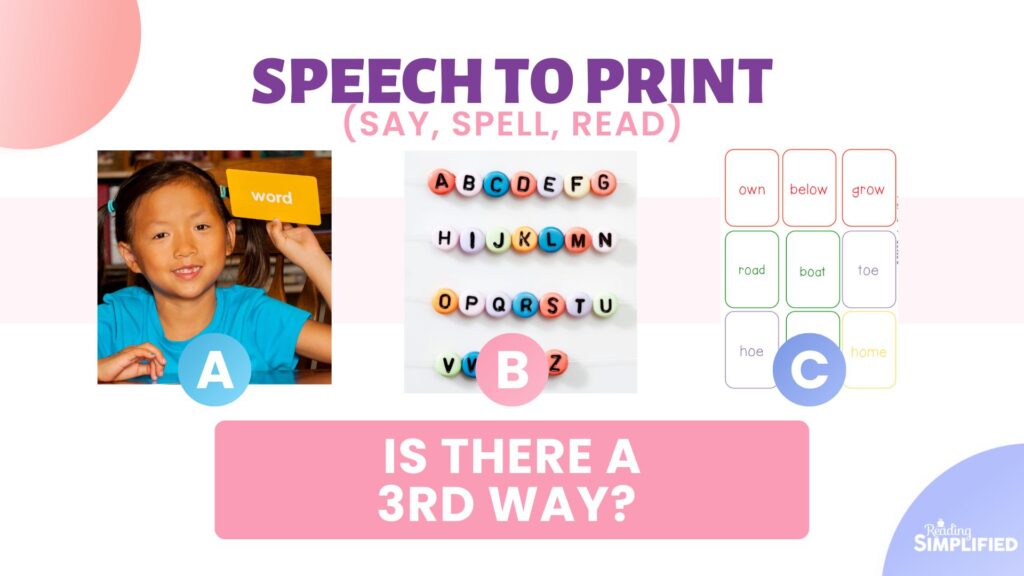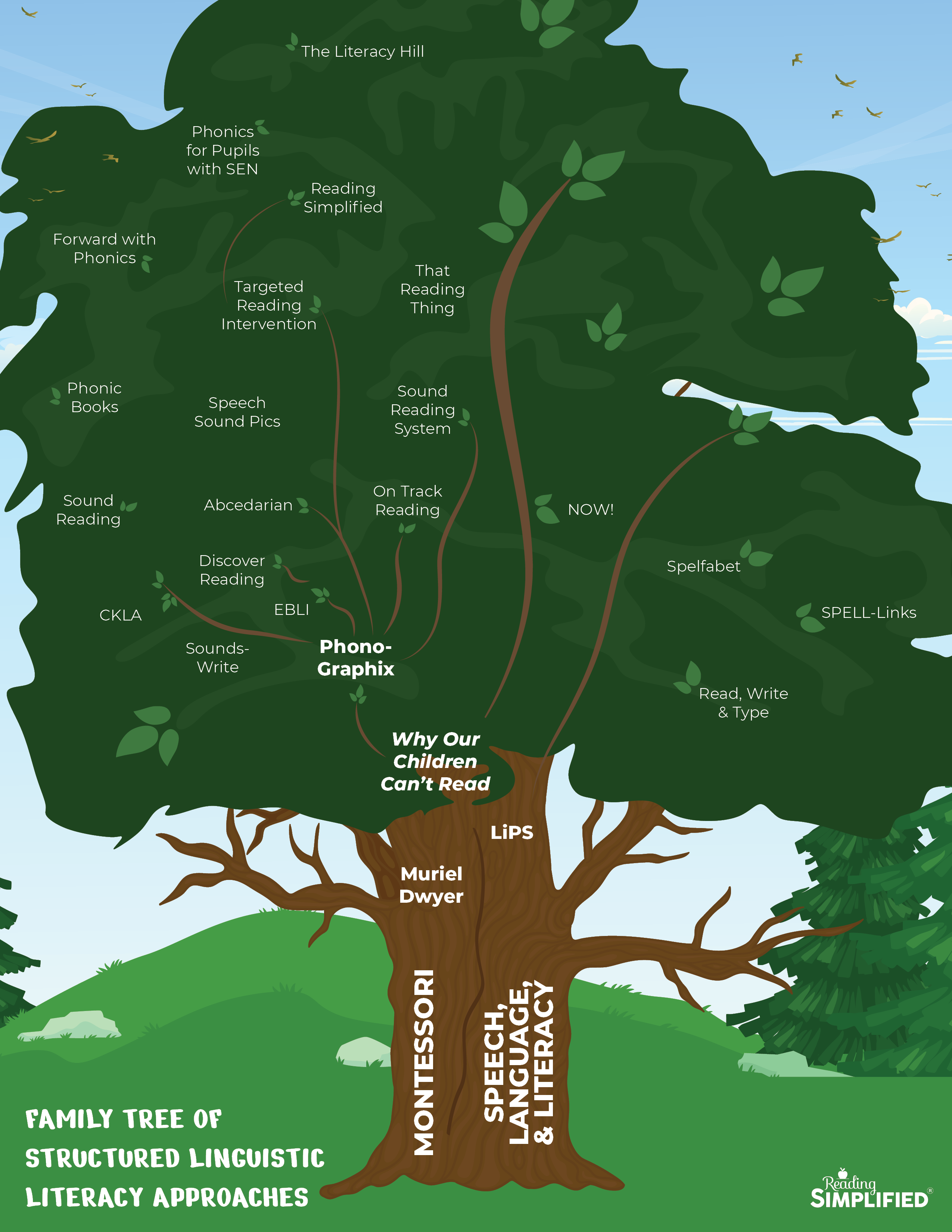
A fall-out of the Reading Wars is that phonics programs mostly stagnated. In their struggle against whole language and balanced literacy, phonics was always clearly in the right, right?
But for over 50 years, the science of how the brain learns to read has marched steadily forward, discovery after discovery. And at the same time, most phonics approaches have stayed locked in their original paradigm from the 1930’s or 50’s.
Some have tacked on a little more phonological awareness or phonemic awareness as a separate component, but the original paradigms have not been reworked in light of contemporary research.
When scientists discovered that reading is built on the back of speech, for instance, why didn’t phonics programs start organizing instruction based on phonology, rather than the adult reader’s lens of letters and spellings?
I was honored to present to Donna Hejtmanek's highly-engaged Facebook group, Science of Reading: What I Should Have Learned in College on this topic of "speech to print" approaches. Some call these "speech to print" approaches. Some call them "linguistic phonics."
Whatever the name, there may be important insights to glean from this refinement of a synthetic phonics approach. If you missed it, you're welcome to watch below!
During the talk, I shared a tentative family tree of speech to print approaches. I've been "collecting" programs that share some or all of the principles mentioned in the above video for many, many years. This depiction below is the result of this work.
If you have suggestions for additions or edits, I'd be pleased to hear them!

Now we're mulling around the name, "Structured Linguistic Literacy," instead of "Speech to Print."
What do you think? Please comment below!


This was a great presentation! Thank you for lending clarity to supporting dramatically improved practice.
I appreciate this Tammy! 🙂
Thanks for a great presentation! I am a homeschooler mum and learnt so much from this video. I know there are two more high quality sound to print reading programs called Open Court Headway (1970s?) and Pinwheels by Rooted in Language (brand new). I’ve been following Muriel Dwyer/ Montessori as my daughter is still young but I need to move her to a reading program with a scope and sequence soon!
Glad you enjoyed it Holly. It’s great to have more programs to consider adding. I wonder what the roots of Pinwheels are? Speech and language?
If you haven’t seen our scope and sequence here at Reading Simplified, you can see a one level here.
Interesting! I wouldn’t have thought that Riggs was as organized around phonology, as I was trying to make the case for here. I used that many years ago so I can’t recall many specifics. Thanks Maria.
I’m curious what your thoughts are about the Heggerty Bridge to Reading program? It seems to be based on phonemic awareness. What do you know about it?
Thanks for the questions Sheila! I have seen samples and it keeps PA apart from phonics and decoding in the early days. This is one area of big concern for me as it dramatically slows progress, especially for those most in need of acceleration in reading. The research has been clear for awhile even though many programs don’t appear to follow it–phonemic awareness is best taught in connection with letters and decoding. The IDA Fact Sheet on Phoneme Awareness is one place to learn more about this. And the esteemed researcher Dr. Susan Brady gave a thorough presentation about this here a few months ago. Reading Simplified and other speech to print (aka Structured Linguistic Literacy) approaches will provide much faster, stronger achievement for beginners and striving readers from my experience.
my grand daughter is 7.5 in math, biut below in 4th grade reading . I would appreciate all the help I
i could get. Jd
Joretta, I’m sorry for her struggle! If she’s several years behind in reading achievement, she will likely benefit from intensive instruction from an expert reading teacher. If this hasn’t worked in the school setting yet, then looking for a local tutor may be very useful. Some communities have volunteer clinics for those with reading difficulties.
We also help caregivers to learn our system, yet it does take time and patience for a beginning teacher to learn our diagnostically-based system. Once the system is understood, children usually grow rapidly. Joining the Reading Simplified Academy here will offer that. But some parents and caregivers are looking for a more scripted, day-to-day program that doesn’t adjust closely to the child’s needs, but feels easier to get started with. The Reading Simplified Academy won’t offer that type of program.
I do hope she is able to get additional support–she CAN learn to read yet it often takes someone pushing outside of the school system for this to be accomplished.
I loved your talk. I’m a homeschool mom and looking for more of a scripted program to teach the way you have brought up. Are there any programs you suggest for homeschool parents to use?
Thanks for asking! I would still recommend the Reading Simplified Academy. While we don’t offer scripted lesson plans because we want adults to be diagnostic, the main course that we offer is designed to support anyone, including homeschoolers, to efficiently and effectively teach sound-based decoding to their learners affordably. The book Reading Reflex or the program ABeCeDarian Reading are scripted options that follow a speech-to-print approach.
Is there a reason why Diane McGuinness’s ‘Sound Steps to Reading’ (2008) isn’t on the family tree?
No! Good catch Jenny! I agree it fits but I just forgot about it. 😐 We’ll try to fix it.
Thanks, Marnie. I wondered if it had been omitted because it doesn’t start with your ‘map’ type of lesson. In fact I don’t think it includes it at any time. The adult starts by reading a story aloud and getting the children to listen for just one target sound (the first is /p/) in different positions in words – not just ‘pig’ and ‘top’ but also ‘pretty’, ‘happy’, and ‘perfectly’. When two more correspondences have been similarly taught in the next two lessons, children start reading words by saying the taught sound for each letter from left to right and blending the sounds: pop, tot, pot, top. They then ‘copy each word on a piece of lined paper several times’ and are subsequently asked to ‘write from memory, sounding out aloud as they write’.
I didn’t recall that it started that way! Interesting. We do something similar that we call “Buddy Reading” so that even beginners can “read” from Day 1 of school, with high scaffolding by the teacher.
What about the “All About Reading “ program by Maria Rippel?
From what I have seen, that has a more traditional phonics approach to the code: organized by spellings not sounds and expects many phonics rules and syllable types to be learned.
Curious your thoughts on Explode the Code? Used as a fun supplement, not the full program.
It could be ok for extra practice Erika. I would prefer games usually but I do know of at least one tutor who uses it for a supplement.
Once trained in a Speech to Print approach, many materials you already have can be used as a supplement—as long as you continue to follow the principles of Speech to Print and carry over strategies such as Blend As You Read and Write & Say.
However, materials designed for early code practice can be tricky. If used independently, students may develop the habit of guessing based on visual characteristics rather than focusing on decoding. Many early phonics materials also introduce blends as chunks rather than promoting blending through CVCC, CCVC, and CCVCC word structures. That’s the case with Explode the Code, which can be problematic. You can read more about effective blending strategies here: https://readingsimplified.com/teach-blending-sounds-read-words/.
Our Pre-K and Kindergarten Student Materials are robust, so while we encourage apps and computer games to supplement word work, especially in differentiated literacy centers (https://readingsimplified.com/20-best-reading-apps/), and some members like to use decodable books alongside our printable passages, I’d be hard-pressed to think of a reason teachers would need additional supplementation.
I’m a homeschool parent with a 3.5 year old reading BOB books (the first set) and going through a traditional phonics program. She loves reading, but is struggling as we introduce more and more complex words. Is there a Reading Simplified curriculum for homeschool parents to purchase? I’m looking for a parent-led curriculum.
This issue of a student struggling with more complex words is a common one. Reading Simplified is a great program to help with this! Parents, tutors, and teachers learn the Reading Simplified methods in our academy. As you progress through the academy, more of the materials are available for you. As a parent, you can make choices along the way for what is best for your student. We have many homeschooling parents in Reading Simplified who have found a successful way to teach their children to read. We welcome you to search out more here! ReadingSimplified.com/academy